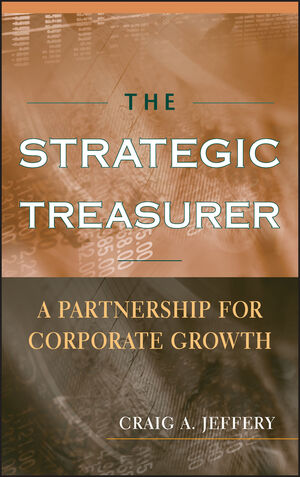The Strategic Treasurer: A Partnership for Corporate GrowthISBN: 978-0-470-40777-6
Hardcover
320 pages
July 2009
 This is a Print-on-Demand title. It will be printed specifically to fill your order. Please allow an additional 10-15 days delivery time. The book is not returnable.
|
||||||
Preface xiii
Acknowledgments xix
Chapter 1 Building the Case for Being a Strategic Treasurer 1
Volatility and Turbulence as Opportunity 2
Resiliency, Diversification, and Due Diligence 3
Being a Strategic Business Partner 4
It Is Good to Be Needed 4
Technology Has Improved 5
Summary 5
Chapter 2 First Things for the New Treasurer 7
Study the Business 8
Assess Treasury 10
Identify Risks 13
Socializing Your Assessment 14
Put Your Team Together Like a Puzzle 15
Creating and Socializing the Vision and Plan 17
A Time for Action 18
Ongoing Intellectual Curiosity 19
Summary 19
Chapter 3 Being a Partner, Not a Vendor 21
Avoiding Inevitable Pitfalls 22
Keeping in Between the Two Lines 23
Know What Is Important to the Organization and to
Its Partners 27
Summary 29
Chapter 4 Managing Relationships 31
Scope of the Relationship Management Plan 32
Key Components of a Relationship Management Plan 33
Plan and Process for Accomplishing the Objectives 34
Rationale for Formally Documenting Relationships 41
Request for Proposal 44
Summary 45
Chapter 5 Owning Cash and the Five Os of Treasury 47
The Os of Treasury 48
Centralized or Decentralized Treasury 48
Taking Ownership 52
Protecting the Balance Sheet 56
Summary 59
Chapter 6 Cash Boot Camp for Treasurers 61
Cash 61
A Tale of Two Types of Cash 62
Disbursement Example 64
Collection/Receivable Example 66
Discussion 71
Technology Enables Appropriate Cash Recording and Reporting 71
Cash Implications 74
Summary 75
Chapter 7 Owning Working Capital 77
Two Definitions of Working Capital 78
Two Different Measurements for Working Capital 79
Working Capital Impact on Organizational Value 84
Differences Between Liquidity and Historical Working Capital Measures 87
Projecting Working Capital Usage and Variations 89
Steps Needed to Optimize Working Capital 90
Summary 92
Chapter 8 Differences Between a Process View and a Silo View 93
The Process Perspective Is Vital 93
Symptoms of a Silo View 97
Fighting the Silo Mentality with the Process 99
Summary 100
Chapter 9 Financial Risk Management, Part One: Considering Risk Through the Eye of the Beholder 101
Risk 102
Summary 109
Notes 109
Chapter 10 Financial Risk Management, Part Two: Altering the Risk a Company Faces to Match the Risk It Desires 111
Risk Management Choices 112
Possible Reasons for Hedging 114
Value in Risk Management 116
Volatility and Impact 117
What to Hedge? 119
Financial Risk Management Process 120
Treasurer’s Role 124
Black Swans 126
When Do We Hedge? 126
No Cheers for Hedges; It’s the Objective That Matters 127
Summary 127
Notes 129
Chapter 11 Losses and Fraud: What Can Keep Treasurers Awake at Night 131
Situations of Loss 133
Fraud 138
Summary 143
Chapter 12 Communication: Mars and Venus: Minimizing Communication Conflict Between Treasurers and Controllers 145
Cash 147
Forecasting 149
Working Capital 152
Controls 154
Summary 155
Chapter 13 Building and Developing the Treasury Team 157
Putting the Puzzle Together 158
Developing the Team 160
Summary 163
Chapter 14 Understanding and Maximizing the Use of Treasury Technology Tools 165
Technology Supports the Treasury Role, and Treasury Supports the Organization 166
Treasury Technology Landscape 167
Extension and Visibility Services 168
Treasury Workstation and the Technology Landscape 170
The Order of Activities 175
Respecting Your Time: A Tale of Dashboards and Reports 175
Other Treasury Systems 177
Managing Financial Processes 184
Summary 187
Notes 187
Chapter 15 Advice from Various Treasury Leaders 189
Change Management 189
Risk Management 192
Relationship Management 194
Mindset and Perspectives of the Treasurer 197
Developing Treasury Staff 200
Vision, Strategy, and Execution 201
Reading List 202
Summary 202
Chapter 16 Volatility and Liquidity Management 205
Protecting the King 205
Volatile Times 206
Financial Crisis of 2007+ 206
Financial Instrument Risk 207
Counterparties 211
Foreign Exchange Rates 212
Commodities 213
Rating Agencies 217
Banks and Insurance Companies 217
Governments 221
Summary 222
Chapter 17 Achieving Visibility to Your Liquidity: Visibility and Process-Automation Requirements for the Strategic Treasurer 223
Achieving Visibility to Liquidity Requires Internal and External Data 225
Prerequisites to Achieving Visibility 230
Connecting Through Networks 231
Assessing Threats and Impacts to the Organization’s Liquidity 237
Summary 241
Chapter 18 Envisioning Treasury in the Future 243
Treasury’s Role in the Corporation 244
Stewardship: Technology Developments and Green Treasury 244
Everything as a Service: Cloud Computing Comes to Treasury 245
Visibility and Risk Management 248
Relationship Power Shifts 251
Liquidity and Balance Sheet Management 252
Chairing the Working Capital Council and Advising Business Areas 253
Cash, Checks, and Miscellaneous Projections 253
Some Things Will Not Change 254
Summary 254
Chapter 19 “Not-to-Do” List for the Treasurer 257
Relationship Management 258
Technology Decisions and Perspectives Don’ts 260
Staffing, Resources, and Consultants 261
Projects and Communication 261
Decisions, Debates, and Assumptions 262
The Crowd: Follow or Take the Road Less Traveled 263
Some Basics 264
Summary 265
Appendix 267
Index 275



